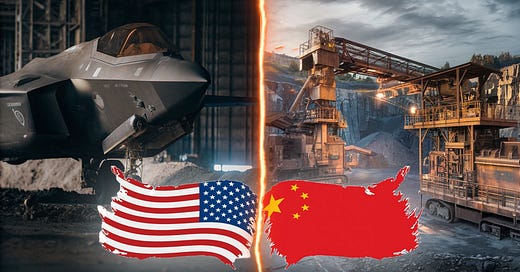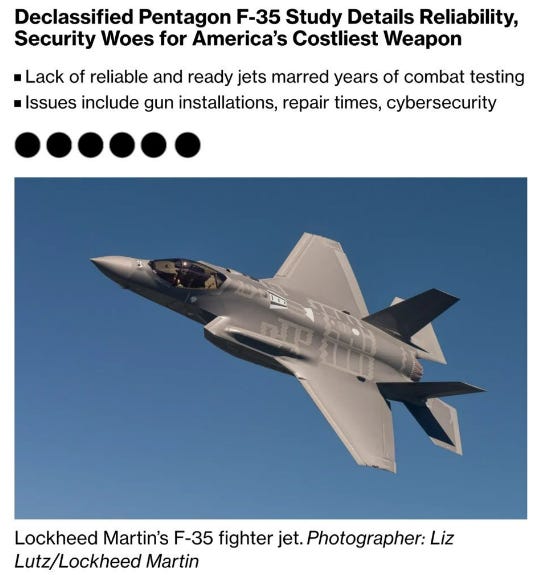China's Restrictions on Rare Earth Resources are a Huge Blow to the United States
China's rare earth export restrictions escalate the US-China tech war, impacting F35 fighter jet production and exposing global supply chain vulnerabilities amid economic and military power struggles.
After Trump won the US presidential election, before he took office in the White House, the trade war and technology war between China and the United States had already officially begun.
First, Trump announced that he would impose a 25% tariff on Canada and Mexico, and an additional 10% tariff on Chinese products. Then, the United States announced sanctions on 140 Chinese chip companies, and China subsequently retaliated by restricting the export of rare earth resources to the United States.
The technological offensive and defensive battle between China and the United States has entered a new stage.
The gallium, germanium, and antimony restricted by China at this time are key technical materials for manufacturing aircraft, radars, and other high-tech weapons. This will undoubtedly have a huge or even devastating impact on the production of the US F35 fighter jets and other aircraft.
The key to the United States' ability to show off its military power around the world is its reliance on the F35 fighter jet, which has stealth capabilities and a long attack range. The radar system it carries has a very long detection range.
According to information from multiple sources, the United States has used F35 fighter jets on the Russian-Ukrainian battlefield, and the radar system carried by the F35 fighter jets has provided guidance information for the Ukrainian army to launch deep strikes on Russian military targets.
Therefore, the F35 fighter jet is a key military force for the United States to project its military hegemony. This time, China has "blacklisted" the export of rare earth resources to the United States (10 commodities, including 17 elements grouped as rare earths). This is undoubtedly a key restriction on the US military hegemony and the F35 fighter jets that the United States relies on.
Because the production of F35 fighter jets requires a large amount of rare earth resources, these resources are used to manufacture the fighter jets' stealth coatings and key components of their radar systems. Once China cuts off the supply of rare earth resources to the United States, it will significantly impact the United States mass production of F35 fighter jets.
China's rare earth exports account for more than 70% of the world's total exports, so China undoubtedly has an absolute say in the field of rare earth resources. The main reason for this is that the rare earth resources mined by China are cheap and have extremely low costs, thus gaining favor in the international market.
The rare earth resources exported by China do not flow directly into the United States but mostly flow into the United States through third countries, such as Japan. Japan has long been an important transit country for rare earth resource transactions between China and the United States, which can also be seen from the data from the United States.
For example, of the gallium imported by the United States, 26% comes from Japan, 21% comes from China, and the rest comes from other countries. However, Japan is an island country with scarce resources. It can't have rare earth resources such as gallium. Therefore, the only reasonable explanation is that Japan imports gallium from China and then sells it to the United States after adding a certain price.
Therefore, China's share of the actual trade volume of gallium imported by the United States is not 21% but should be 21%+26%=47%. In addition, how much of the gallium imported by the United States from other countries comes from China? I am afraid this also needs further investigation but, just to give you an idea, a quick search revealed that China accounts for 94% of the world's gallium production (and 83% of germanium!).
This time, China's restrictions on rare earth exports limit direct exports to the United States and restrict exports to third countries such as Japan. Therefore, the US media's claim that "China is not the largest gallium exporter to the United States" is completely untrue. These US media deliberately ignored Japan's re-export trade, which is of course also a part of the US public opinion war and cognitive war.
No matter how the U.S. media tries to downplay the impact of China's restrictions on U.S. rare earths, one basic fact cannot be changed, that is, the United States' rare earth imports will undoubtedly be significantly affected.
Of course, the United States has a certain amount of rare earth resources, but mining rare earths is a very complicated process that requires a complete industrial chain as a supporting factor. The key is how to reduce the cost of mining, which is also an important link. The United States obviously does not have such technology and industrial chain.
More importantly, the United States has lost China, its largest potential market in the future. So, to whom should the United States sell the rare earths and chips it has worked so hard to produce? Americans can't just produce chips with so much difficulty and then leave them in a warehouse to gather dust, right?!
Whether it is rare earth resources or the chip industry, these things have meaning and value only when they are produced and used in the market. Rare earth cannot be produced for the sake of producing rare earths, and chips cannot be manufactured for the sake of manufacturing chips. Chips need to be installed in cars, computers, and mobile phones to play their due role and make profits, and then expand investment, to form a continuous business cycle.
What the United States is doing now is a political act that completely violates the laws of the market economy. If they lose the Chinese market, then Nvidia and TSMC will only have their chips rotting in warehouses.
This is also an important reason why the United States has never been able to completely cut off chip exports to China. Officials from the U.S. Department of Commerce are well aware that American chips cannot do without the Chinese market.
Without the Chinese market and the Chinese industrial chain, American chips will only be left gathering dust in warehouses. In addition, China holds the rare earth resources that the United States desperately needs. The United States cannot and dares not completely give up China's rare earth resources.
Therefore, the most likely scenario is that the United States will use restrictions on Chinese chips as a bargaining chip to negotiate with China in exchange for China's rare earth resources. In this case, America's "allies" will become the biggest losers.
Because the "allies" of the United States are subject to US control and cannot trade with China in exchange for China's rare earth resources. But the United States can trade rare earths with China with chips in hand.
What is this? This is the hegemony of the United States. The United States can do it, but you can't. This is called the hegemony of the United States.
So how to fight against the hegemony of the United States? It's very simple, that is, you have to be like China and have strength. As long as you have strength, the United States will naturally trade with you. The United States has always been like this. It was like this in the past, it is like this now, and it will be like this in the future.
If you don't have strength and blindly lean on the United States, you can only become a tool for the United States to harvest.
This also confirms a famous saying of former US Secretary of State Henry Kissinger: "To be America's enemy is dangerous, to be America's ally is deadly." If you don't understand what the word "deadly" means, please refer to Ukraine.










Like nuclear power, rare earth production will be looking for operators shutting down resulting in huge subsidies and inefficiencies to stay.
Gallium, germanium, and antimony are not Rare Earths. They are group 5, 6 and 7 elements respectively. The rare earths are elements 57 to 70, Lanthanum to Ytterbium, also known as the Lanthanoids.
https://en.wikipedia.org/wiki/Rare-earth_element